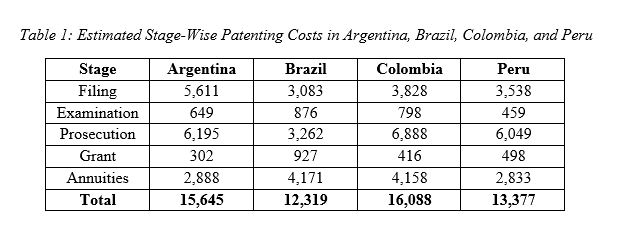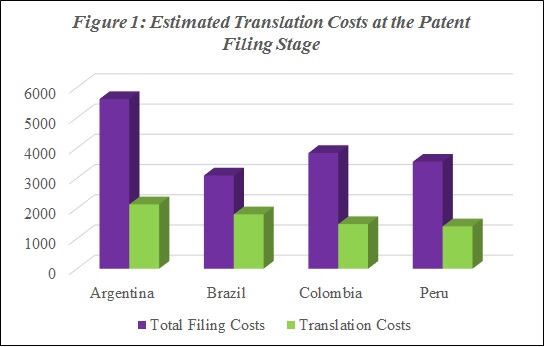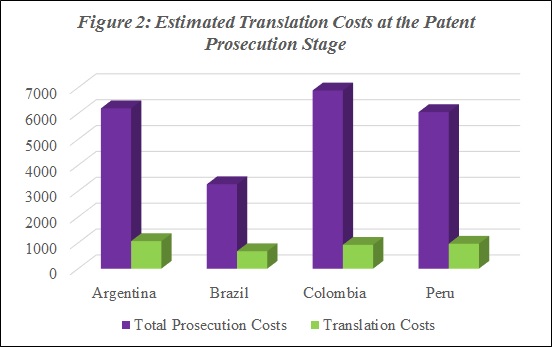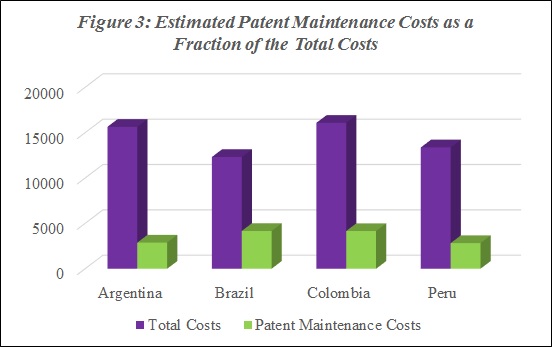
Patent Protection Costs in South America
Published on 13 February 2019
When thinking of South America, the first thing that springs to mind is the diverse natural resources that the region encompasses, including long, towering mountain ranges and sprawling rivers that nurture deep, biodiverse rainforests. However, this region offers so much more, including growing economic opportunities. In this article, we shall delve into the patent protection costs in some major South American economies.
The Andean Community
In 1969, five South American countries decided to "unite voluntarily with the objective of achieving an integral, more balanced, and autonomous development through Andean, South American, and Latin American integration" (http://www.comunidadandina.org). Thus, the Andean Pact was born, with Bolivia, Chile, Colombia, Ecuador, and Peru as its member states. The Pact was subsequently renamed as the "Andean Community" in 1996. Lima, Peru currently serves as the Community's headquarters.
Bolivia, Colombia, Ecuador, and Peru are the current member states, which encompass a population of around 100 million and combine together for a GDP of approximately one trillion U.S. Dollars (Craig Dempsey; 2016). While Chile withdrew its membership in 1976, Venezuela, which joined in 1973, withdrew its membership in 2006.
Intellectual Property legislation is harmonized within the Andean Community. The legal framework for this harmonization is contained in Decision 486, which came into force on December 1, 2000, thereby superseding Decision 344, which was enacted in 1993 (Natalia Tobón; 2001). However, unlike some other Patent Offices, such as the European Patent Office and the Gulf Cooperation Council Patent Office, there is no centralized Andean Patent Office. As a result, separate patent applications will have to be filed in each of the four member states for complete patent protection within the Andean Community.
MERCOSUR
"MERCOSUR", also referred to as the "Common Market of the South", was established in 1991, with the signing of the Treaty of Asunción, by Brazil, Argentina, Uruguay, and Paraguay. Though the initial objective of the Treaty was the setting up of free-trade zones between member countries, the objectives have subsequently expanded to customs unification and common market for the free movement of manpower and capital
(http://www.lni.unipi.it/stevia/Organizzazioni/page03.html).
The organization is the most significant regional trading bloc in South America and "accounts for almost three-fourths of total economic activity" on the continent. It is also the fourth largest trading bloc in the world, after the European Union, the North American Free Trade Agreement, and the Association of Southeast Asian Nations (Hem Basnet and Gyan Pradhan; 2017).
Venezuela, which withdrew from the Andean Community in 2006, became the fifth member state in 2012 (https://globaledge.msu.edu/trade-blocs/mercosur/history). However, its membership was subsequently suspended in August 2017 (Andres Schipani; 2017).
Unlike the Andean Community, no framework for the harmonization of Intellectual Property legislation exists across the member states of MERCOSUR. Though the organization has adopted two Industrial Property protocols (i.e. one on trademarks and the other on industrial models and designs), neither protocol has been unanimously ratified by the member states to date, which is a prerequisite for their entry into force (Carlos Adrián Garaventa and Pablo Wegbrait; 2017).
Patenting in the Andean Community and the MERCOSUR Economies
As per the World Intellectual Property Indicators 2017 report published by the World Intellectual Property Organization, the National Intellectual Property/Patent Offices of the Andean Community countries collectively received close to 4,000 patent applications in 2016, with over half of the patent applications being filed in Colombia. This number is expected to increase copiously in the coming years as the Community develops and Foreign Direct Investment inflows increase. In the MERCOSUR countries, on the other hand, close to 33,000 patent applications were filed in 2016, with over 80% of the patent applications being filed with the Brazilian Patent Office.
Patent Protection Costs in South America
Let us now study the costs involved in obtaining and maintaining a patent in the economies of the Andean Community and MERCOSUR that received at least 1,000 patent filings in the year 2016 (i.e. Argentina, Brazil, Colombia, and Peru). Since a patent is typically maintained for at least six to ten years, we shall consider the costs from August 2018 through July 2028. There are three categories of costs involved: official fees, attorney charges, and translation costs.
For the purposes of this article, we shall consider a patent specification drafted in English comprising 45 pages (including five pages of drawings) and 15 claims, which is to be filed electronically by a company (i.e. large entity) to which the patent rights have been assigned in Argentina, Brazil, Colombia, and Peru, through the Paris Convention. Further, we shall consider that the applications contain a priority claim to a parent patent application filed in the U.S and that a single document is to be legalized in the applicable jurisdictions.
For the above scenario, the total costs to file a patent application, get the patent issued, and maintain the patent are approximately $57,500. These estimates are based on the values found within the fee schedules supplied by at least five independent Intellectual Property law associates in each jurisdiction and are inclusive of Value Added Tax (added to the attorney charges and translation costs) in Argentina, Colombia, and Peru.
As shown in Table 1, the estimated costs are spread across the five different stages of the patenting process: Patent Filing, Patent Examination, Patent Prosecution, Patent Grant, and Patent Annuities/Patent Renewal Fees/Patent Maintenance Fees.
 Patent Filing Costs and Patent Specification Translation Costs
Patent Filing Costs and Patent Specification Translation Costs
In Argentina, the estimated patent filing costs are inclusive of: the official fees for each claim of the patent specification in excess of 10 claims; the official patent maintenance fees in respect of the first year and the second year, and the attorney charges for handling the patent maintenance payments; the attorney charges for legalizing and recording the Power of Attorney; and the attorney charges for recording an Assignment Document with the Argentinian Patent Office.
In Brazil, the estimated patent filing costs are inclusive of the attorney charges for filing the Power of Attorney and an Assignment Document with the Brazilian Patent Office.
In Colombia and Peru, the estimated patent filing costs are inclusive of: the official fees for each claim of the patent specification in excess of 10 claims; the attorney charges for legalizing the Power of Attorney; and the official fees for claiming a single priority, in addition to the attorney charges for handling the priority claim.
Translation of the patent specification into the official language is mandatory in all four jurisdictions. The estimated costs of translating 40 pages of a patent specification into Spanish (Argentina, Colombia, and Peru) and Portuguese (Brazil) vary between $1,400 in Peru to $2,130 in Argentina. When expressed as a percentage of the total patent filing costs, the translation costs vary between about 38% of the total filing costs in Argentina and Colombia to about 58% of the total filing costs in Brazil (Figure 1).
 Patent Application Examination Costs
Patent Application Examination Costs
All four jurisdictions follow a deferred system of examination. The estimated costs of patent application examination are inclusive of the official fees for requesting an examination of each claim of the patent specification in excess of 10 claims in Argentina and Brazil.
Patent Prosecution Costs, Translation Costs, and Patent Grant Costs
The estimated patent prosecution costs are based on the average number of office actions with substantive objections being issued in each jurisdiction (based on our research). These costs are inclusive of the attorney charges for reporting each office action, preparing a response to each office action, and processing the response to each office action.
As is the case with patent filing, translation is also required during patent prosecution in each of the four jurisdictions. Assuming 10 pages of translation per prosecution action, the estimated translation costs vary between $675 in Brazil to $1,065 in Argentina. When expressed as a percentage of the total patent prosecution costs, the translation costs vary between about 13% of the total estimated costs in Colombia to about 21% of the total estimated costs in Brazil (Figure 2).

An official patent grant fee or patent issue fee is charged in Brazil and Peru. Argentina and Colombia, on the other hand, do not charge such a fee.
Patent Maintenance Fees and Patent Annuity Fees by Country
When expressed as a percentage of the total estimated patent protection costs, the estimated patent annuity fees by country vary between about 18% of the total estimated costs in Argentina to about 34% of the total estimated costs in Brazil (Figure 3).

In Brazil, where the quantum of patent maintenance fee to be paid depends on whether the application is pending or whether the patent has been granted, the estimated patent maintenance costs are based on a patent being issued in 2026.
Companies across the world are fast recognizing the need for implementing a well thought out and judicious international patent filing strategy, both for offensive and defensive purposes. Like chess, patenting is a game of strategy, in which the implementation of a wrong move or the non-implementation of what could have been a right move, could have serious and far-reaching consequences. In such a scenario, it is imperative that due deliberation be given for the inclusion of vibrant economies with high potential for growth, such as the South American economies, in the formulation of a global patent filing strategy.
However, the lack of a single regional patent office makes the process of obtaining patents in South America an extremely challenging and cumbersome one as applicants have to navigate their way through a bundle of varying national legislations, each mandating its own set of procedures. Having a precise idea of the stage-wise costs that could be incurred will go a long way in facilitating strategic decision-making and budget forecasting. This will also ensure that no major setbacks or shocks occur downstream during the patenting process, such as a high variance occurring between the budgeted spend and the actual spend, which could force the underlying teams to scramble back to the drawing board to determine cost-cutting avenues.
Patent Portfolio Software
Worried about keeping pace with the dynamic patent costs landscape? The
Global IP Estimator and the
Portfolio Estimator – Patents are smart, robust, and state-of-the-art international Patent cost calculators from the stables of
Quantify IP, which greatly simplify the arduous and challenging task of Intellectual Property budgeting management. They offer what traditional Intellectual Property docketing software and patent and trademark management software do not - they can
instantly and accurately calculate the costs of worldwide protection for either a single patent, trademark, design, or utility model, or a portfolio of patents, designs, or utility models, respectively. The calculations may be fine-tuned to the level of any particular stage of an Intellectual Property across its lifecycle.
The addition of Quantify IP's Patent Cost Calculators has
empowered the decision-makers in many Fortune 500 companies and over 70% of the top 100 IP law firms in the U.S. to solve diverse challenges in managing Intellectual Property budgets. To see what we can do for you, email us at
qipcontact@quantifyip.com or call us at +1-808-891-0099.
Venkatesh Viswanath (Senior Content Strategist, Quantify IP) contributed to this article.
Exchange Rates Used: 1 U.S. Dollar = 34 Argentine Pesos, 4.11 Brazilian Real, 2,979.24 Colombian Pesos, and 3.2917 Peruvian New Sol
Note: The estimates and fees depicted in this article are based on the Official Fee Schedules as on August 30, 2018

 for assistance.
for assistance.

